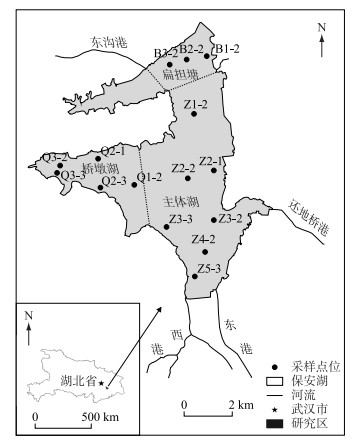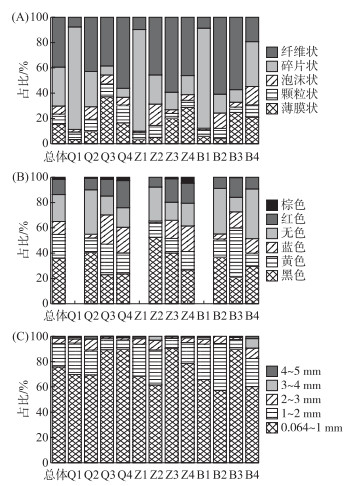微塑料(microplastics, MPs)的概念由英国学者Thompson于2004年提出[1],大多数来自于较大塑料垃圾的分解[2]。科学家在人类母乳、肺部、血液等器官和组织中检测到微塑料,足以证明微塑料与人体健康关系紧密。海洋微塑料中约80% 来源于陆地[3],主要通过地表径流[4]和大气沉降[5]等进行迁移。我国内陆淡水系统、河流的微塑料污染不容小觑[6]。内陆湖泊是内陆主要的淡水储存地[7],也是其最主要的组成部分[8]。湖泊在长江中下游地区分布最为密集且多封闭,微塑料易沉积湖底形成累积,从而成为下游河流微塑料的主要来源以及上游微塑料的汇集点[9],扮演着污染物“汇”的角色[10]。同一地区的湖泊微塑料浓度均高于河流中的浓度。因此研究湖泊微塑料污染对于人类生活生产、经济发展以及健康极具意义。与各国一样,中国内陆湖泊的微塑料研究开展较晚,目前仅对一些重要区域展开了调查,数据还比较匮乏。研究主要集中在长江、珠江流域和部分城市内部水域[11],内陆湖泊中仅在太湖[12]、巢湖[13]、鄱阳湖[14]、洞庭湖[15]、青海湖[16]滇池[17]和洪湖[15]等开展了微塑料来源、分布和污染特性等方面研究。
2010—2019年的微塑料研究统计[18]表明,我国地表水系河流和湖泊中微塑料丰度分别为0.0039~7.9和0.34~8.9 items/L,主要源于污水排放和渔业用具等。研究表明很大一部分塑料垃圾留在了内陆系统[10]。目前对于微塑料在淡水环境中的分布以及污染特性是国内外广泛关注热点[19]。国外Bertoldi等[20]调查位于巴西南部的瓜伊巴湖,发现淡水表层微塑料分布和组成等与人口密度、土地占用、风和地质水文过程相关。Napper等[21]发现恒河高达91% 的微塑料为纤维状。Xiong等[22]对弗拉特黑德湖的研究表明,减少洗衣能够有效控制微塑料污染。我国环境微塑料研究近年快速发展[23],孙雪纯等[24]调查位于青藏高原无人环境中的特拉什湖,发现其微塑料污染较低。陈馨等[13]证实巢湖主要的微塑料污染来源是渔业活动以及生活污水排放。张启吉等[12]发现太湖流域湖水微塑料污染处于中等水平。由这些研究得出,无论发达地区还是偏远地区,湖泊中均有微塑料被检出,且微塑料丰度与环境因子表现出一定的相关性。流域内微塑料污染主要是源自流域于人类活动,并且影响其分布。
保安湖是大冶三大湖泊中最后一处水质保持较好的湖泊,是长江中游南岸、鄂东南极具代表性的阻隔型浅水湖泊。目前对于此类湖泊的研究较少,江湖阻隔湖泊相较于水文自由流通的湖泊,其生物多样性以及食物网结构趋于简化[25]。1950s-1970s,为了防洪以及渔业生产,长江中下游流域修建了大量堤坝,阻隔了河流和湖泊之间的联系。因此开展保安湖微塑料丰度研究对于探究长江中下游流域的微塑料污染具有一定的借鉴意义。保安湖作为大冶乃至黄石市最后一块湖泊圣地,被誉为大冶的“肾”,是保安人民的母亲湖。至今关于保安湖的研究主要集中于水质、生物多样性和生态效益等方面,对其开展微塑料污染研究具有重要意义。本文以大冶市保安湖为研究对象,基于季节性研究目的进行采样,探究其表层水体微塑料丰度及分布特征,并将微塑料丰度与主要水质因子监测数据进行相关分析,探究其丰度与水质因子之间的联系,以期为进一步研究淡水阻隔型湖泊中微塑料污染情况、生态影响及其防控提供基础数据和科学依据。
1 材料与方法 1.1 研究区概况保安湖(30°15′N,114°43′E)位于千湖之省的湖北省大冶市境内, 地处江汉平原东部边缘,是一个重要的中型浅水草型湖泊。受东南季风影响冬冷夏热,湖区历年平均气温为17.4℃,湖水水质较好无工业污染,长年保持在地表水II类水以上。湖区历年平均降雨量1478.1 mm,时空分布不均。保安湖共包括4个湖区:主体湖(ZT)、桥墩湖(QD)、扁担塘(BD)以及肖四海, 面积分别为2667、800、333和133 hm2。肖四海原来本是保安湖西北部的一个湖汊,1970s通过土堤与主体湖区完全阻隔,其他两个湖区虽有石堤阻隔但属于半阻隔,故仍可通过缺口进行湖水交换[25]。湖区水深均在1.5~2.5 m之间,湖水主要通过地表径流和降雨补给。
1.2 样品采集根据湖区产汇流特征、水文情势以及附近工业和当地渔业的发展现状,本研究在水流相互流通的3个湖区共设置15个采样点。具体采样点位分布如图 1所示。分别在春(2021年4月)、夏(2021年7月)、秋(2021年10月)、东(2022年1月)4个季节进行采样。采样方法参考杨泽川[26]、尹诗琪等[27]的研究进行改进,用5 L不锈钢采样桶采集表层1 m的水样20 L,使用浮游生物网(孔径64 μm)缓慢过滤水样,用纯水将截留在网上的残留物冲洗至具塞玻璃瓶中,并加1 mL甲醛溶液避光保存,每个采样点取2个平行样。采样工作完成之后统一运回实验室置于冰箱中4℃保存。现场采样时使用测深锤确定监测点的水深,通过黑白塞氏盘(Sechidisc)进行透明度(SD)的测定,使用HACH多功能水质分析仪(HydrolabDS5X、庚圣自动化科技有限公司、上海)测定浊度(Tur)、温度(Tem)、溶解氧(DO)和酸碱度(pH)值。采集的水样冷藏后带回实验室后分别采用酸性高锰酸钾氧化法、碱性过硫酸钾消解紫外分光光度法)和钼酸铵分光光度法测定化学需氧量(CODMn)、总氮(TN)和总磷(TP)浓度。

|
图 1 保安湖采样点分布 Fig.1 Distribution of sampling sites in Lake Baoan |
样品预处理参照已有研究进行[28],依据水样体积加入30% H2O2溶液,用锡箔纸密封玻璃瓶瓶后移入65℃、80转/min的恒温振荡器箱中,振荡72 h以去除样品中有机物干扰。消解完成后使用ZOOSCAN扫描仪对消解后的水样进行扫描并回收。将回收样品真空抽滤在0.45 μm混合纤维滤膜上,并放入玻璃培养皿中,贴好标签,置于体式显微镜(南京江南永新光学有限公司JSZ6)下观察颜色、形态并记录。挑选出微塑料颗粒或疑似微塑料的颗粒,使用傅里叶变换红外光谱仪(Thermo Nicolet IS50)对微粒进行成分分析鉴定。因样本量大,记录粒径、颜色和形状后,每个点位随机挑选约10个颗粒进行扫描,4个季度总计扫描约600个颗粒,基本包含所有的形状、尺寸以及颜色的组合。由于相同外观的微塑料组成成分并不一定相同[29],因此本研究中红外光谱并不代表保安湖中所有微塑料的化学组成类型。在探测器光谱范围为650~4000 cm-1、分辨率为8 cm-1的条件下,每个样品进行3次扫描。利用OMINIC软件对获得的光谱图与标准谱图库进行相似度匹配,根据吸收峰来判断微塑料的聚合物类型,相似度大于70% 才被认定为微塑料[30],统计各种聚合物类型在扫描颗粒中的比例。
1.4 质量控制和质量保证为保证最大程度地减小实验误差,在水样采集阶段、水样处理阶段、扫描阶段、抽滤阶段中使用的玻璃容器以及不锈钢器皿使用前后均使用去离子水冲洗。所有实验均在密闭实验室环境下进行,实验人员穿干净整洁的棉质实验服并佩戴无粉乳胶手套进行操作,实验过程中挑选和转移微塑料时动作缓慢,所有设备在使用结束后使用设备专需的保护套覆盖,避免空气尘土中存在微塑料的影响。设置去离子水代替实验水样进行空白对照,观察对比对照组与实验组滤膜上的微塑料分布,在对照组仅检测到(0.35±0.12)items/L的塑料颗粒。
1.5 数据处理使用ArcGIS 10.2软件绘制采样点位示意图;使用SPSS 26.0软件进行各采样点微塑料丰度与CODMn、水深、Tem、DO、pH、Tur、SD、TN和TP的Pearson相关性分析;依据ZOOSCAN扫描仪扫描的图像用Image J软件统计微塑料粒径和丰度;使用Origin 2022和Excel 2021完成图表绘制。微塑料的丰度单位用items/L表示。
2 结果与分析 2.1 微塑料丰度及时空特征保安湖15个采样点表层水样微塑料的检出率为100%,平均丰度范围为1.17~40.45 items/L,平均值为(16.20±2.23)items/L,主体湖、扁担塘和桥墩湖的微塑料平均值分别为(16.95±2.33)、(19.33±3.74)和(20.72±4.52)items/L。各点位全年平均丰度值见表 1,其中位于扁担塘的采样点B1-2丰度最高,桥墩湖采样点Q3-3最低,两者相差3倍。
| 表 1 保安湖表层水体微塑料全年平均丰度 Tab. 1 Average abundance of microplastics in surface water of Lake Baoan throughout the year |
各湖区不同季节的微塑料平均丰度如图 2所示。桥墩湖、主体湖以及扁担塘平均丰度最低值均出现在7月;桥墩湖最高值出现在2022年1月;主体湖和扁担塘最高值均出现在2021年10月。3个湖区微塑料丰度有明显的时间差异性。

|
图 2 保安湖表层水体微塑料丰度的时空分布 Fig.2 Spatial and temporal distribution of microplastics abundance in surface water of Lake Baoan |
由表 2可知,2021年7月,微塑料丰度与水深呈显著相关(P < 0.01);2022年1月,微塑料丰度与CODMn指数和Tur指数呈现出一定的相关性(P < 0.05)。除此之外,微塑料的丰度与水质指标不存在显著的相关关系。
| 表 2 微塑料丰度与水质指标的Pearson相关性分析 Tab. 2 Pearson correlation analysis of microplastics abundance and water quality index |
通常可以通过微塑料的形状确定其来源[31]。本研究将微塑料形态分为纤维、薄膜、碎片、颗粒和泡沫5类。纤维主要是呈细长的线型;薄膜为边缘光滑的透明片状;碎片为边缘尖锐非透明块状或条状;颗粒多为不规则的状粒,质地坚硬;泡沫多为疏松多孔的椭圆状结构。保安湖水体微塑料的形态分布如图 3A所示。从总体上看,纤维状占比最大达到了40.01%,其次是碎片状和薄膜状,分别是31.31% 和14.32%,颗粒状占7.85%,而泡沫状仅占6.51%。从时空上看,3个湖区的微塑料形态在时间上差异性较大,在空间上差异性较小,春季碎片状在3个湖区占了很大的比例,另外3个季节除冬季扁担塘湖区以碎片状居多外,其余皆以纤维状为主。四个季节里,保安湖中纤维状的微塑料占很大的比例,尤其是每年的丰水期(4—10月),所测的水样中纤维状微塑料占比均约50%。

|
图 3 保安湖表层水体微塑料形态、颜色、尺寸的时空分布(Q代表桥墩湖;Z代表主体湖;B代表扁担塘;数字1、2、3、4分别代表春、夏、秋、冬4个季节) Fig.3 Morphology, color and size distribution of microplasticsin surface water of Lake Baoan by time and space (Q stands for Qiaodun Lake; Z stands for the main lake; B stands for Biantan Pond; numbers 1, 2, 3 and 4 represent the four seasons of spring, summer, autumn and winter, respectively) |
本研究将保安湖微塑料的颜色分为6种:黑色、无色、黄色、蓝色、红色和棕色,由于春季数据缺失,其余3个季节的颜色分布如图 3B所示。微塑料色彩丰富主要与自身的材质和来源有关[32],整体上以黑色、无色和黄色为主,分别占36.16%、21.31% 和18.68%,红色、蓝色和棕色则分别占了12.09%、10.18% 和1.58%。
从时空角度上看,各个湖区在颜色分布上差异比较大,在桥墩湖区域夏季微塑料颜色占比以黑色和无色为主,分别为40.66% 和35.16%。秋季略有变化,黑色和无色微塑料占比分别降至23.06% 和24.19%,黄色和蓝色微塑料占比升至24.19% 和23.23%,冬季与秋季相似,黑色、黄色、蓝色、无色、红色和棕色微塑料占比分别为23.59%、16.55%、20.28%、15.45%、21.38% 和2.62%。在主体湖区域,同样是以黑色微塑料为主,夏季至冬季,黑色微塑料颜色占比由26.90% 增长至40.10%,然后又降到20.59%,与另外两大湖区略有不同的是主体湖区中红色微塑料占比略高于其他湖区。在扁担塘区域,夏季中黑色与无色微塑料占比最大,分别为36.80% 和36.00%,其余组别占比很小;在秋季,无色微塑料占比减少,降至13.19%,黄色微塑料占比增加,并与黑色微塑料占比相近,分别为27.22% 和27.09%;在冬季,无色微塑料占比增加,并成为占比最大的颜色,达到39.22%,黑色微塑料占比略有减小,为29.41%,黄色微塑料占比减至10.46%。
本研究将微塑料按粒径大小分为0.064~1、1~2、2~3、3~4和4~5 mm 5类。不同粒径大小的微塑料占比存在明显差异(图 3C)。随着粒径的增大,微塑料的丰度在逐渐减小,这与李征等[33]、白璐等[34]研究的相关结论相似。从整体上看,保安湖微塑料的粒径主要分布在0.064~1 mm内,全年平均占比高达82.57%,占比最小的是粒径为4~5 mm的微塑料,仅为0.49%。粒径在0~2 mm的微塑料在4个季节都达到总体的90% 左右。在桥墩湖区域,处于0.064~1 mm粒径的微塑料占比在4个季节都是最高的,但是有所差异的是春、夏两季0.064~1 mm粒径微塑料占比约为70%,秋、冬两季增加到90% 左右。在主体湖,春季0.064~1 mm粒径微塑料占比为68.38%,1~2 mm粒径微塑料占比为24.82%。夏季0.064~1 mm粒径微塑料占比与春季相近,为69.57%,1~2 mm粒径微塑料占比为19.57%。秋季0.064~1 mm粒径微塑料占比有所增加,并在冬季下降。在扁担塘湖区,各粒径微塑料规律与另外两大湖区相似。整体来看,3大湖区均以0.064~1 mm粒径微塑料为主,且从时间序列上看,呈现先升高后下降的趋势。
具有更小粒径的微塑料甚至是纳米塑料具有更大的比表面积,对于污染物的吸附能力也更强,易被水生动物吸食进入体内,并且聚集体内,再通过生物链的富集作用,对环境生态造成更大的威胁,这也是当前以至将来的研究重点[35]。
2.3 保安湖微塑料的主要成分为鉴定保安湖微塑料材质,在显微镜下挑选出约600个颗粒,利用傅里叶红外光谱进行检测,通过对官能团的特征峰分析,确定其组成成分。检出聚乙酸乙酯(polyvinyl acetate, PVAC)、聚乙烯(polyethylene, PE)、低密度聚乙烯(low density-polyethylene, LDPE)、聚对苯二甲酸乙二醇酯(polyethylene glycol terephthalate, PET)、聚丁二酸二乙二醇酯(poly(butylene succinate-co-diethylene glycol succinate), PBSD)、聚苯乙烯(polystyrene, PS)、聚酰胺(polyamide, PA)、聚丁二烯(polybutadiene, PB)、聚偏二氟乙烯(polyvinylidene difluoride, PVDF)和丙烯酸-丙烯酰胺共聚物(poly(acrylate-co-acrylamide), PAAM)共10种类型的微塑料。其中PE占比最大,达到了35.4%,其次为PS、PET和PVAC,占比分别为17.2%、8.33% 和8.31%。
3 讨论 3.1 保安湖微塑料分布特征目前微塑料的采集、提取、消解和检测等方法并不统一[36],不同的方法间各有优缺点,且不同采样方法会导致样品代表的差异性,也降低了数据之间的可比性。本研究采用浓缩样本法收集表层水体中的微塑料,此种方法筛网的孔径决定了分离的微塑料尺寸[37],且筛网孔径越小,微塑料的丰度就越大[38]。微塑料的检测采用ZOOSCAN扫描仪、体式显微镜和傅里叶红外光谱相结合,目视分析法测定样品丰度和颜色,虽然操作简单,但由于杂质存在观察者容易误判,主观性较强。
与部分典型淡水环境中微塑料浓度相比(表 3),保安湖微塑料污染较为严重。时间上表现为微塑料丰度丰水期明显低于枯水期,与李文华等[39]对鄱阳湖微塑料污染物的研究结论相同。
| 表 3 部分典型淡水湖泊中微塑料丰度特征 Tab. 3 Characterization of microplastic abundance in some typical freshwater lakes |
微塑料在空间分布上也存在显著差异,与蒋婷婷等[44]研究阿哈湖的结论相同,本研究中全年平均丰度较高的点位均靠近湖岸且位于居民区附近,丰度较低的点位在处于湖区的中心或离湖岸较远,与文晓凤等[45]调查发现岳阳南湖表层水体微塑料分布呈现“中高边低”有所不同。人类活动频繁地区会导致采样点的高水平污染[46-47],微塑料污染水平与污染源距离关系密切。苏磊等[41]研究发现,太湖靠近人类生活区域的东南部地区微塑料丰度是中部地区的6倍。三峡水库的支流香溪河中城镇化较高的地区微塑料丰度也显著高于其他地区[48]。长江流域微塑料丰度整体上也呈现沿岸高、中间低的规律[49]。了解丰度和空间分布规律是解决微塑料污染的关键所在[50],本研究中各水质指标与微塑料丰度虽不具明显的相关性,但其他相关研究已发现人类活动、水体流速、降水以及风速等因素是影响微塑料分布的主要原因[51],人类活动如洗衣等会使水体的有机质和悬浮物浓度升高,进而造成溶解氧降低。如Browne等[52]研究发现微塑料分布与研究区人口密度密切相关。陈圣盛等[53]发现香溪河表层水体中流速较低的点位微塑料丰度偏高,反之亦然。
3.2 保安湖微塑料来源及影响因素分析不同研究区域的微塑料种类差异与当地产业、发展情况和人口密度有很大关联。微塑料的形态、聚合物类型可以反映其来源[24],被丢弃在环境中的塑料垃圾,都可能会随大气或地表径流进入湖泊[54-55]。小粒径微塑料更易重新悬浮和运输,这也导致其在环境中占比较大[56]。颜色形态以黑色、纤维状占比最大,郝若男等[50]研究发现乌梁素海水体中纤维状也是主要的污染类型,而其他的形状相对较少。目前,纺织业和渔业都被认为是纤维状微塑料的主要来源,保安湖在实施长江十年禁渔计划前渔业发达,在扁担塘和主体湖东部有许多与鱼塘相连的排水沟渠,由于长时间的渔业活动,由沟渠排出大量养殖废水,这是造成污染的主要原因之一[57]。此外,城镇居民的生活污水也会随着入湖河流进入湖区。
PE因其化学性质稳定,具有良好的耐低温性能,是最普通的塑料材质,在日常生活中常用于制造薄膜、包装袋以及日常杂用等。薄膜主要用于农业生产,化肥和农用覆膜[58]等,都是微塑料的潜在来源,且很难从土壤中进行回收[59]。保安湖周围土地利用类型以农业用地、草地以及林地居多,2020年区域内第一产业占比33.5%,地膜会在生长季节破碎,进而通过地表径流、大气传输等途径进去湖区。本研究中微塑料丰度高的点位均位于人流量大的居住区,这些地方有大量的生活垃圾且工业污染较为严重,较多污染源导致了微塑料在湖区大量富集。
4 结论1) 保安湖微塑料丰度范围为1.17~40.45 items/L,平均值为(16.20±2.23)items/L。其分布呈现明显的时空差异性,从时间尺度上看,微塑料丰度在枯水期显著高于丰水期,空间尺度上,越靠近湖中心其丰度越低,说明保安湖微塑料分布与人类活动关系密切。
2) 保安湖微塑料颜色主要是黑色,形状以纤维状为主,尤其是在丰水期,所测样品纤维状微塑料占比均达到了50%。各尺寸占比具有明显差异,呈现出粒径越大微塑料丰度越小的趋势。整体上看以小尺寸(0.064~1 mm)为主,时间序列上呈先增加后有所下降的趋势。材质主要成分依次为PE、PS、PET和PVAC。
3) 结合微塑料的形状、颜色和种类的鉴别结果以及城市的实地踏勘,保安湖水体中的微塑料污染受多方面因素影响,主要包括周边村庄和居民的生产废弃塑料和生活、生产污水的排放等,也与研究区水文条件有关。
| [1] |
Thompson RC, Olsen Y, Mitchell RP et al. Lost at sea: Where is all the plastic?. Science, 2004, 304(5672): 838-838. DOI:10.1126/science.1094559 |
| [2] |
Koelmans AA, Redondo-Hasselerharm PE, Nor NHM et al. Risk assessment of microplastic particles. Nature Reviews Materials, 2022, 7(2): 138-152. DOI:10.1038/s41578-021-00411-y |
| [3] |
Xu CY, Zhang BB, Gu CJ et al. Are we underestimating the sources of microplastic pollution in terrestrial environment?. Journal of Hazardous Materials, 2020, 400: 123228. DOI:10.1016/j.jhazmat.2020.123228 |
| [4] |
Amamiya K, Saido K, Chung SY et al. Evidence of transport of styrene oligomers originated from polystyrene plastic to oceans by runoff. Science of the Total Environment, 2019, 667: 57-63. DOI:10.1016/j.scitotenv.2019.02.383 |
| [5] |
Allen S, Allen D, Phoenix VR et al. Atmospheric transport and deposition of microplastics in a remote mountain catchment. Nature Geoscience, 2019, 12(5): 339-344. DOI:10.1038/s41561-019-0335-5 |
| [6] |
Zhao X, Chen H, Jia QL et al. Pollution status and pollution behavior of microplastic in surface water and sediment of urban rivers. Environmental Science, 2020, 41(8): 3612-3620. [赵昕, 陈浩, 贾其隆等. 城市河道表层水及沉积物中微塑料的污染现状与污染行为. 环境科学, 2020, 41(8): 3612-3620. DOI:10.13227/j.hjkx.201912236] |
| [7] |
Zhang GZ, Ren H, Zhou TH et al. Research progress on the distribution and biotoxicity of microplastics in freshwater environment. Water & Wastewater Engineering, 2022, 58(1): 162-171. [张国珍, 任豪, 周添红等. 淡水环境中微塑料的分布及生物毒性研究进展. 给水排水, 2022, 58(1): 162-171.] |
| [8] |
Du YB, Chen QW, Wang ZY et al. Safety evaluation of typical lake drinking water sources in Jiangsu Province. Water Resources Protection, 2020, 36(5): 71-78. [杜云彬, 陈求稳, 王智源等. 江苏省典型湖泊饮用水源地安全综合评价. 水资源保护, 2020, 36(5): 71-78.] |
| [9] |
张颖, 金晶, 刘翔. 淡水环境中微塑料的来源、赋存研究进展. 科技风, 2020, 440(36): 143-144. |
| [10] |
Xiong X, Wu CX. Lakes—Hotspots of microplastic pollution in inland water bodies. Chinese Journal of Nature, 2021, 43(4): 243-250. [熊雄, 吴辰熙. 湖泊——内陆水体微塑料污染的热点区域. 自然杂志, 2021, 43(4): 243-250.] |
| [11] |
Zhang SF, You XX, Gao L et al. Research progress on detection methods, distribution and hazards of microplastics in freshwater environment. City and Town Water Supply, 2022(6): 67-72. [张山风, 游晓旭, 高乐等. 淡水环境中微塑料检测方法、分布与危害研究进展. 城镇供水, 2022(6): 67-72. DOI:10.3969/j.issn.1002-8420.2022.06.016] |
| [12] |
Zhang QJ, Liu T, Liu L et al. Distribution and sedimentation of microplastics in Taihu Lake. Science of the Total Environment, 2021, 795: 148745. DOI:10.1016/j.scitotenv.2021.148745 |
| [13] |
Chen X, Zhang ZW, Liu YZ et al. Compositional and distributional characteristics of microplastics in water samples of Chaohu Lake. Research of Environmental Sciences, 2022, 35(12): 2716-2721. [陈馨, 张仲伟, 刘运钊等. 巢湖水体中微塑料组成及分布特征. 环境科学研究, 2022, 35(12): 2716-2721.] |
| [14] |
Yuan WK, Liu XN, Wang WF et al. Microplastic abundance, distribution and composition in water, sediments, and wild fish from Poyang Lake, China. Ecotoxicology and Environmental Safety, 2019, 170: 180-187. DOI:10.1016/j.ecoenv.2018.11.126 |
| [15] |
Wang WF, Yuan WK, Chen YL et al. Microplastics in surface waters of Dongting Lake and Hong Lake, China. Science of the Total Environment, 2018, 633: 539-545. DOI:10.1016/j.scitotenv.2018.03.211 |
| [16] |
Xiong X, Zhang K, Chen XC et al. Sources and distribution of microplastics in China's largest inland lake—Qinghai Lake. Environmental Pollution, 2018, 235: 899-906. DOI:10.1016/j.envpol.2017.12.081 |
| [17] |
Yuan HY, Hou L, Liang QB et al. Correlation between microplastics pollution and eutrophication in the near shore waters of Dianchi Lake. Environmental Science, 2021, 42(7): 3166-3175. [袁海英, 侯磊, 梁启斌等. 滇池近岸水体微塑料污染与富营养化的相关性. 环境科学, 2021, 42(7): 3166-3175. DOI:10.13227/j.hjkx.202012100] |
| [18] |
Zhang ZY, Chen YG. Current research and perspective of microplastics (MPs) in soils (dusts), rivers (lakes), and marine environments in China. Ecotoxicology and Environmental Safety, 2020, 202: 110976. DOI:10.1016/j.ecoenv.2020.110976 |
| [19] |
Cao YQ, Lin L, Pan X et al. CiteSpace-based visual bibliometric analysis of research status and emerging trends of microplastics in freshwater environment. Journal of Yangtze River Scientific Research Institute, 2023, 40(2): 153-160. [曹玥祺, 林莉, 潘雄等. 基于CiteSpace的淡水环境微塑料研究现状及新兴趋势的可视化文献计量分析. 长江科学院院报, 2023, 40(2): 153-160. DOI:10.11988/ckyyb.20220298] |
| [20] |
Bertoldi C, Lara LZ, de L Mizushima FA et al. First evidence of microplastic contamination in the freshwater of Lake Guaíba, Porto Alegre, Brazil. Science of the Total Environment, 2021, 759: 143503. DOI:10.1016/j.scitotenv.2020.143503 |
| [21] |
Napper IE, Baroth A, Barrett AC et al. The abundance and characteristics of microplastics in surface water in the transboundary Ganges River. Environmental Pollution, 2021, 274: 116348. DOI:10.1016/j.envpol.2020.116348 |
| [22] |
Xiong X, Tappenbeck TH, Wu CX et al. Microplastics in Flathead Lake, a large oligotrophic mountain lake in the USA. Environmental Pollution, 2022, 306: 119445. DOI:10.1016/j.envpol.2022.119445 |
| [23] |
Liu HT, Zhou ZW, Ge Q. Pollution status of microplastics in important water bodies in China. Liaoning Urban and Rural Environmental Science & Technology, 2022, 42(9): 42-47. [刘慧婷, 周志文, 葛琦. 微塑料在我国重要水体中的污染现状. 环境保护与循环经济, 2022, 42(9): 42-47.] |
| [24] |
Sun XC, Hou SG, Huang RH et al. Characteristics, sources and ecological risks of microplastics in Telashi Lake in Hoh Xil. Acta Scientiae Circumstantiae, 2023, 43(2): 231-240. [孙雪纯, 侯书贵, 黄壬晖等. 可可西里特拉什湖中微塑料污染特征、来源和生态风险. 环境科学学报, 2023, 43(2): 231-240. DOI:10.13671/j.hjkxxb.2022.0188] |
| [25] |
Qu X, Gao WQ, Lu Y et al. Connectivity loss in lake on fish communities—A case study of Bao'an Lake. Acta Hydrobiologica Sinica, 2023, 47(9): 1476-1487. [屈霄, 高雯琪, 陆颖等. 湖泊阻隔对鱼类群落的影响——以保安湖为例. 水生生物学报, 2023, 47(9): 1476-1487.] |
| [26] |
Yang ZC, Hu H, Wang XH et al. Studies on the input characteristics of microplastics of rivers entering the Laizhou Bay. Transactions of Oceanology and Limnology, 2021, 43(5): 73-81. [杨泽川, 胡泓, 王秀海等. 莱州湾入海河流的微塑料输入特征研究. 海洋湖沼通报, 2021, 43(5): 73-81.] |
| [27] |
Yin SQ, Jia FL, Liu XY et al. The distribution of microplastics and their influence factors in surface seawater and tidal flat sediments in Qingdao coast. Acta Scientiae Circumstantiae, 2021, 41(4): 1410-1418. [尹诗琪, 贾芳丽, 刘筱因等. 青岛近岸表层海水和潮滩沉积物中微塑料的分布及其影响因素. 环境科学学报, 2021, 41(4): 1410-1418. DOI:10.13671/j.hjkxxb.2020.0453] |
| [28] |
Cheng XY, Yang LH, Song XF. Characteristics of microplastics in the overlying water and sediments of Baiyangdian. Environmental Science, 2023, 44(8): 4344-4352. [程昕煜, 杨丽虎, 宋献方. 白洋淀上覆水及沉积物中微塑料赋存特征. 环境科学, 2023, 44(8): 4344-4352. DOI:10.13227/j.hjkx.202207093] |
| [29] |
Li ST, Ding F, Flury M et al. Macro- and microplastic accumulation in soil after 32 years of plastic film mulching. Environmental Pollution, 2022, 300: 118945. DOI:10.1016/j.envpol.2022.118945 |
| [30] |
Zhou GY, Wang QG, Zhang J et al. Distribution and characteristics of microplastics in urban waters of seven cities in the Tuojiang River Basin, China. Environmental Research, 2020, 189: 109893. DOI:10.1016/j.envres.2020.109893 |
| [31] |
Rosal R. Morphological description of microplastic particles for environmental fate studies. Marine Pollution Bulletin, 2021, 171: 112716. DOI:10.1016/j.marpolbul.2021.112716 |
| [32] |
Chen YP, Jiang L, Xu CY et al. Distribution characteristics and sources of microplastics in surface seawater of the East China Sea. Marine Environmental Science, 2023, 42(2): 315-325. [陈永平, 姜璐, 许春阳等. 东中国海表层海水微塑料分布特征及其来源综述. 海洋环境科学, 2023, 42(2): 315-325.] |
| [33] |
Li Z, Gao CM, Yang JL et al. Distribution characteristics of microplastics in surface water and sediments of Haizhou Bay, Lianyungang. Environmental Science, 2020, 41(7): 3212-3221. DOI:10.13227/j.hjkx.201910005 |
| [34] |
Bai L, Liu XH, Chen YZ et al. Current status of microplastics pollution in Tianjin coastal waters. Environmental Chemistry, 2020, 39(5): 1161-1168. [白璐, 刘宪华, 陈燕珍等. 天津近岸海域微塑料污染现状分析. 环境化学, 2020, 39(5): 1161-1168.] |
| [35] |
Cole M, Lindeque P, Halsband C et al. Microplastics as contaminants in the marine environment: A review. Marine Pollution Bulletin, 2011, 62(12): 2588-2597. DOI:10.1016/j.marpolbul.2011.09.025 |
| [36] |
Zhao XR, Li W. Research progress on detection methods of micro plastics in environment. Yunnan Chemical Technology, 2022, 49(3): 9-11. [赵茜芮, 李伟. 环境中微塑料检测方法研究进展. 云南化工, 2022, 49(3): 9-11.] |
| [37] |
Song XW, Wu XF, Song XP et al. Research progress on the extraction and separation methods of microplastics. Environmental Chemistry, 2022, 41(3): 793-800. [宋小卫, 吴晓凤, 宋小平等. 微塑料的提取分离方法研究进展. 环境化学, 2022, 41(3): 793-800.] |
| [38] |
Lindeque PK, Cole M, Coppock RL et al. Are we underestimating microplastic abundance in the marine environment? A comparison of microplastic capture with nets of different mesh-size. Environmental Pollution, 2020, 265: 114721. DOI:10.1016/j.envpol.2020.114721 |
| [39] |
Li WH, Jian MF, Yu HP et al. Characteristics of microplastic pollution and temporal-spatial distribution in the sediments of the five rivers in the Lake Poyang Basin. J Lake Sci, 2019, 31(2): 397-406. [李文华, 简敏菲, 余厚平等. 鄱阳湖"五河"入湖口沉积物中微塑料污染物的特征及其时空分布. 湖泊科学, 2019, 31(2): 397-406. DOI:10.18307/2019.0209] |
| [40] |
Li WG, Jian MF, Nie JM et al. Spatiotemporal distribution and multi-source characteristics of microplastics in the soil and water environment of Poyang Lake Wetland, China. Chinese Journal of Applied Ecology, 2022, 33(10): 2862-2870. [李文刚, 简敏菲, 聂佳敏等. 鄱阳湖湿地水土环境中微塑料的时空分布及多源性. 应用生态学报, 2022, 33(10): 2862-2870. DOI:10.13287/j.1001-9332.202210.034] |
| [41] |
Su L, Xue YG, Li LY et al. Microplastics in Taihu Lake, China. Environmental Pollution, 2016, 216: 711-719. DOI:10.1016/j.envpol.2016.06.036 |
| [42] |
Zhou G, Xu CY, Shen CS et al. Distribution, composition and ecological risks of microplastics in surface water of the Dianshan Lake. Acta Scientiae Circumstantiae, 2022, 42(4): 214-224. [周刚, 徐晨烨, 沈忱思等. 微塑料在淀山湖水环境的污染分布、组成特征和生态风险. 环境科学学报, 2022, 42(4): 214-224. DOI:10.13671/j.hjkxxb.2021.0351] |
| [43] |
Pan X, Lin L, Zhang S et al. Composition and distribution characteristics of microplastics in Danjiangkou Reservoir and its tributaries. Environmental Science, 2021, 42(3): 1372-1379. [潘雄, 林莉, 张胜等. 丹江口水库及其入库支流水体中微塑料组成与分布特征. 环境科学, 2021, 42(3): 1372-1379. DOI:10.13227/j.hjkx.202006123] |
| [44] |
蒋婷婷. 受不同人为活动影响湖泊中微塑料的分布规律——以贵阳市阿哈湖为例[学位论文]. 贵阳: 贵州大学, 2022.
|
| [45] |
Wen XF, Yin LS, Jiang CB et al. Microplastics in surface water of a typical urban lake: A case study from Nanhu Lake, Yueyang City. Environmental Chemistry, 2022, 41(11): 3579-3588. [文晓凤, 尹令实, 蒋昌波等. 典型城市湖泊岳阳南湖表层水体中的微塑料污染特征. 环境化学, 2022, 41(11): 3579-3588.] |
| [46] |
Zbyszewski M, Corcoran PL, Hockin A. Comparison of the distribution and degradation of plastic debris along shorelines of the Great Lakes, North America. Journal of Great Lakes Research, 2014, 40(2): 288-299. DOI:10.1016/j.jglr.2014.02.012 |
| [47] |
Rochman CM. Microplastics research-from sink to source. Science, 2018, 360(6384): 28-29. DOI:10.1126/science.aar7734 |
| [48] |
Zhang K, Xiong X, Hu HJ et al. Occurrence and characteristics of microplastic pollution in Xiangxi Bay of Three Gorges Reservoir, China. Environmental Science & Technology, 2017, 51(7): 3794-3801. DOI:10.1021/acs.est.7b00369 |
| [49] |
Li TC, Huang XL, Wu CX et al. Microplastic pollution in the Yangtze River Basin: Status quo and control measures. Journal of Yangtze River Scientific Research Institute, 2021, 38(6): 143-150. [李天翠, 黄小龙, 吴辰熙等. 长江流域水体微塑料污染现状及防控措施. 长江科学院院报, 2021, 38(6): 143-150. DOI:10.11988/ckyyb.20210057] |
| [50] |
Hao RN, Shi XH, Liu Y et al. Spatial distribution patterns and influencing factors of microplastics in the waters of Wuliangsu Sea. China Environmental Science, 2022, 42(7): 3316-3324. [郝若男, 史小红, 刘禹等. 乌梁素海水体微塑料空间分布规律及影响因素. 中国环境科学, 2022, 42(7): 3316-3324.] |
| [51] |
Eerkes-Medrano D, Thompson RC, Aldridge DC. Microplastics in freshwater systems: A review of the emerging threats, identification of knowledge gaps and prioritisation of research needs. Water Research, 2015, 75: 63-82. DOI:10.1016/j.watres.2015.02.012 |
| [52] |
Browne MA, Galloway TS, Thompson RC. Spatial patterns of plastic debris along Estuarine shorelines. Environmental Science & Technology, 2010, 44(9): 3404-3409. DOI:10.1021/es903784e |
| [53] |
Chen SS, Li WM, Zhang K et al. Distribution characteristics of microplastics and their migration patterns in Xiangxi River Basin. Environmental Science, 2022, 43(6): 3077-3087. [陈圣盛, 李卫明, 张坤等. 香溪河流域微塑料的分布特征及其迁移规律分析. 环境科学, 2022, 43(6): 3077-3087. DOI:10.13227/j.hjkx.202109268] |
| [54] |
Kor K, Mehdinia A. Neustonic microplastic pollution in the Persian Gulf. Marine Pollution Bulletin, 2020, 150: 110665. DOI:10.1016/j.marpolbul.2019.110665 |
| [55] |
Lin L, Ma LS, Li HX et al. Low level of microplastic contamination in wild fish from an urban estuary. Marine Pollution Bulletin, 2020, 160: 111650. DOI:10.1016/j.marpolbul.2020.111650 |
| [56] |
Chen Y, Zhang LS, Zhou RY et al. Spatial and temporal distribution characteristics and influencing factors of microplastics in Huixian Karst wetland. Journal of Ecology and Rural Environment, 2023, 39(7): 934-942. [陈言, 张漓杉, 周如月等. 会仙岩溶湿地微塑料的时空分布特征及其影响因素. 生态与农村环境学报, 2023, 39(7): 934-942.] |
| [57] |
Liu JH, Li Y, Shen DF et al. Evaluation of pollution statues and the influencing factors in sediment in Bao'an Lake, Hubei Province. Journal of Dalian Ocean University, 2023, 38(4): 680-688. [刘佳豪, 李艳, 申东方等. 湖北省保安湖沉积物污染评价及其影响因子分析. 大连海洋大学学报, 2023, 38(4): 680-688.] |
| [58] |
Huang Y, Liu Q, Jia WQ et al. Agricultural plastic mulching as a source of microplastics in the terrestrial environment. Environmental Pollution, 2020, 260: 114096. DOI:10.1016/j.envpol.2020.114096 |
| [59] |
Yang Y, Li Z, Yan CR et al. Kinetics of microplastic generation from different types of mulch films in agricultural soil. Science of the Total Environment, 2022, 814: 152572. DOI:10.1016/j.scitotenv.2021.152572 |
 2024, Vol. 36
2024, Vol. 36 

